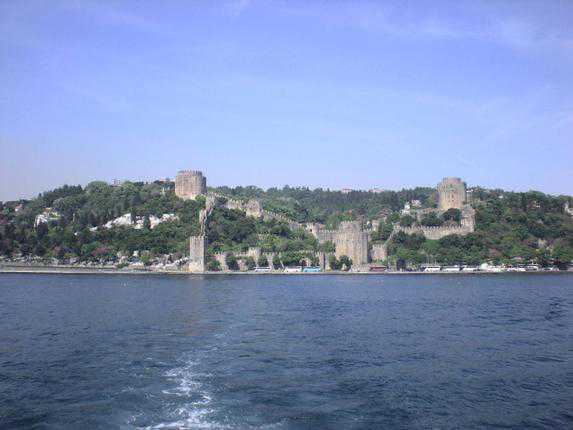
The ramparts of the Rumeli Hisari fort. Photo: Sheila Kumar
Sheila Kumar keeps returning to the blue waters of Istanbul.
I just can’t help it. As I stand looking at the rippling swath of blue water, a line from an old Hindi film song comes to mind: “…tumsa nahin dekha.”
I’m on the European side of Istanbul, staring at the Bosphorus. Over the last four days, I have taken in all of Istanbul’s many delights. I have trawled its winding caddesis (streets), spent hours in its bazaars, eaten tonnes of kebabs, mezes and baklavas, downed many a glass of apple tea. I went for a hamam session with some trepidation but thoroughly enjoyed it. I watched a dervish show with mixed feelings… should something so private be put on public display? I had felt up many Turkish carpets; actually, I was now ready to buy the T-shirt that said: Been There, Done That.
However, I would keep coming back to the bank of the Bosphorus. The river exercised a strange fascination on me; strange because I have seen and appreciated the Thames, Seine, Tiber, Gauadalquivir, the Boyne and many other rivers of Europe, at different times over the years. But this body of water, the world’s narrowest strait used for international navigation is altogether something else.
Vital waters
The 31-km-long Bosphorus connects the Black Sea with the Sea of Marmara. On its shores sits Istanbul, with its 11-million-and-counting inhabitants lucky enough to glimpse the river on their way to work, on their return from work, on their Sunday impromptu picnics in the riverside parks, on their evening strolls, from atop the Galata Tower. Some days, the waters are choppy, steel gray and turbulent. At other times, they are a deep blue with the gentlest ripples disturbing the surface, and raucous seagulls wheeling above the surface.
The Bosphorus is not a river but a sea-strait that divides Istanbul and has many charming legends attached to it. Io, a high priestess of Hera, was transformed into a cow and condemned to wander the earth until she crossed the Bosphorus where she met Prometheus. Jason passed through here on his ship the Argo, en route to securing the Golden Fleece. This is the scene of Noah’s flood. Leander’s Tower stands in the middle of the Bosphorus, and yes, it does refer to that couple, Hero and Leander. There was also a time when concubines fallen out of favour, bodyguards of the Sultan, even a Patriarch, were all killed and their bodies thrown into the Bosphorus.
Given that it is part of the only passage between the Black Sea and the Mediterranean, the Bosphorus has always been of major importance since Byzantine times. Wars have been fought on both sides of the strait; the Roman Emperor Constantine the Great decided to locate the capital of the Eastern Roman Empire, Constantinople, by this strait. In recent times, Russian oil is exported by tankers to western Europe and the US, via the Bosphorus. Two suspension bridges — the Bosphorus Bridge and the Fatih Sultan Mehmet Bridge — stand like magnificent sentinels across the water.
Magnificent sentinels
Besotted as I have become, merely looking at the Bosphorus twice or thrice each day is not enough, so I take a cruise down the river. Like pretty much all of Europe’s riverside cities, the buildings on the banks are a mix of old palaces, small mosques, luxe hotels, and the contemporary many-million-bucks dwellings of Istanbul’s rich and famous. I board at Eminonu, and my cruise vessel gently drifts past the three gems in Istanbul’s crown: the Hagia Sophia, the Topkapi Palace and the Blue Mosque, a precious triptych. We pass the historic Dolmabahce Palace, where Kemal Ataturk spent his last days. A mild breeze keeps the sun’s warmth shrouded and we are soon drifting past the Golden Horn. In a bit, we go under the Bosphorus Bridge, within hailing distance of huge tankers and cargo ships, and come upon the sprawling Rumeli Hisari fort, also known as the Fortress of Europe.
Here and there, we pass fishermen standing still as statues, hopeful of a good catch of lufer (bluefish); their main station is the Galata Bridge and they sell their catch to the many seafood restaurants in the vicinity. Many of these anglers are retired academics and white collar professionals who have turned their hobby into lucrative business. In under two hours, we are at Anadolu Kavagi, where a climb up Joshua’s Hill to the Yoros castle is amply rewarded with a panoramic view of the junction where the Bosporus River meets the Black Sea. Blue skies meet blue water on the far horizon. More of the magic at work.
And when I am back at the Eminonu docks, I treat myself to a fish sandwich and sit staring at the waters. And I mentally make a promise that like Arnie, I’ll be back. That very evening, to see the blue waters lit up by the lights of Istanbul. I can’t help it. It’s the lure of the Bosphorus.
via The Hindu : Life & Style / Travel : Bosphorus magic.